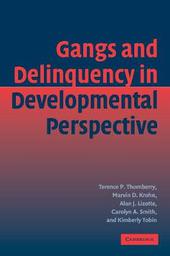
|
Gangs and Delinquency in Developmental Perspective
Paperback / softback
Main Details
| Title |
Gangs and Delinquency in Developmental Perspective
|
| Authors and Contributors |
By (author) Terence P. Thornberry
|
|
By (author) Marvin D. Krohn
|
|
By (author) Alan J. Lizotte
|
|
By (author) Carolyn A. Smith
|
|
By (author) Kimberly Tobin
|
| Series | Cambridge Studies in Criminology |
|---|
| Physical Properties |
| Format:Paperback / softback | | Pages:262 | | Dimensions(mm): Height 229,Width 153 |
|
| ISBN/Barcode |
9780521891295
|
| Classifications | Dewey:364.36 |
|---|
| Audience | | Professional & Vocational | | Tertiary Education (US: College) | |
|---|
| Illustrations |
55 Tables, unspecified; 20 Line drawings, unspecified
|
|
Publishing Details |
| Publisher |
Cambridge University Press
|
| Imprint |
Cambridge University Press
|
| Publication Date |
23 December 2002 |
| Publication Country |
United Kingdom
|
Description
Gang membership has long been understood to have a disruptive influence on adolescent development and to contribute disproportionately to the rate of delinquent crime. The nature of the impact, and the long-term effects on individuals, have not been well understood. This book uses longitudinal data to examine the developmental consequences of gang membership, and its longer term influence on the life course. This longitudinal approach is made possible by data from a study of antisocial behavior, The Rochester Youth Development Study, which followed one thousand adolescents through their early adult years. The subjects include delinquents who were gang members and others who were not, allowing the authors to compare motives, patterns of behavior, and recurring problems with caregivers and the law, education, peer relations, and career paths. The findings indicate that multiple developmental deficits lead to gang membership and that membership leads to an increase in delinquency.
Reviews'... an impressive 16-year investigation into gang membership in Rochester, New York.' Youth & Policy 'I would predict that this book will be cited frequently in future research on gangs, for the authors have provided a rich variety of data on the subject.' Urban Studies
|